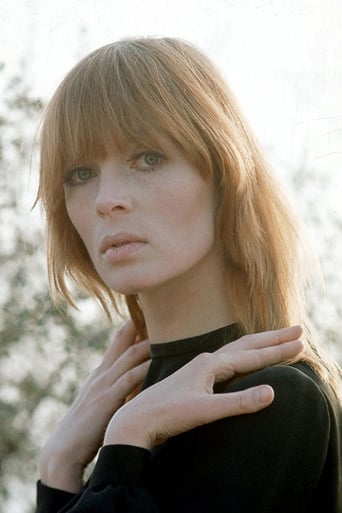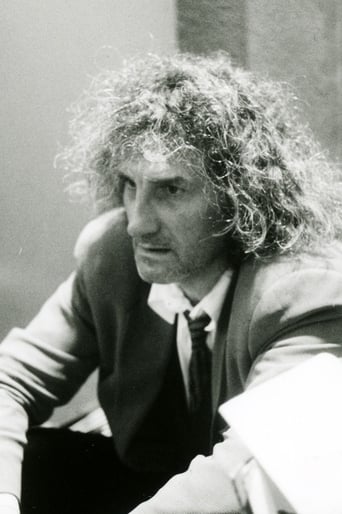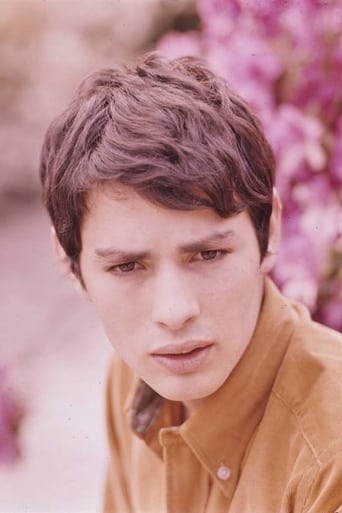Diagonaldi
Very well executed
SpuffyWeb
Sadly Over-hyped
Rio Hayward
All of these films share one commonality, that being a kind of emotional center that humanizes a cast of monsters.
Taha Avalos
The best films of this genre always show a path and provide a takeaway for being a better person.
Rodrigo Amaro
Amidst my usual apathy, often charged at its highest while watching some mediocre films or others that are quite good but sometimes lacking of good rhythm becoming painfully distractive things, "Le Cicatrice Intérieure" managed to do some good without demanding much. On the surface this is hauntingly beautiful, very mesmerizing and very attractive to look at; deep inside within its few spoken words in three languages and in the echoes of nature, the story tries to be poetic, with some brainy meaning but no, it's pure boloney. It's very pretentious yet it's not something harmful. And c'mon it only takes 55 minutes to make its case.The story (if there is one) revolves around a woman (Nico) trapped in the desert trying to get out of there along with a man (played by the film's director/writer Philiippe Garrel), a devil (also him), and one archer (Pierre Clementi, completely naked in all of the scenes he's in) who shares some messages with her. There's other characters, talks about faith, some randomness that knows no limits and that's my take on the plot.I'm not gonna be cruel with this picture due to reasons. It looks like a long student project made in the 1970's, taking advantage of the whole counterculture already existent, and looks like something made out of improvisation after improvisation. It goes like this: everyone involved were under the influence of substances and they came up with this thing. Simple as that. It's not bad, just doesn't make much sense unless you're in the state the makers were, flying high as a kite, alternating illusion with reality, having visions of another world. Despite this theory of mine, "La Cicatrice Intérieure" ("The Inner Scar") is fun to watch. Mysterious, a little bit engaging but complicated to understand. Garrel knows how to produce mythical images and hypnotic moments of pure beauty (I discovered this film after one gif of a scene with a horseman and his horse surrounded on a circle of fire and a kid watching them), it's fine but too bad that in this case he didn't knew how to develop substantial ideas worthy of praise and debate. It's filled of symbols but they don't arouse anything valuable or of interest. I can say he's a better director now, his "La Naissance de L'amour" was one of those surprising works where you ask yourself deep questions you've never thought of before. Surreal at its average level, "La Cicatrice Intérieure" is a watchable piece for those who have patience to endure its enigmatic moving images. I liked it but I really wanted more. Didn't die of boredom like most people but haven't got rewarded with the effort. OK, only for the beauty, sometimes that's all we need to move through life once in a while. 6/10
chaos-rampant
The landscapes used here are absolutely mesmerizing, to begin this on a positive note, a mixture of salty flatlands and volcanic deserts. And the ways the camera navigates them are also remarkable, the subjective motions against vast horizons.But it is a work of art, no quotation marks required. Art as has evolved in the past century is nothing, in the sense that it is not anything, and is not required to mean anything beyond the means of expression. It hinges on the artist's selective framing, and usually some means to engage the curiosity of our gaze. But it does not need to be anything more than a urinal set up on a pedestal, to use the oft-quoted example.Art being a two-way road of course, a kind of conversation, we are not required to engage it deeply. We can marvel as well as scoff, with all that is implicit in either. So I will let others tease out the symbolic quota of the film for some lengthy dissertation where the naked male rider stands in for whatever it is he does.What I am interested in, is something that penetrates the soul of my being, tethers images and threads them in ways I wouldn't imagine. Images of some purity, by definition selectively framed, that expand into the world they are framed from; and in ways that address the subjective experience of framing by watching. Naturally, dreams and myth have provided ample background from which to cull images. The idea is that we are treading the grounds of an unconscious sleep but which gives rise to the elements of life around us, a ritual sleep that matters because it supplies lucid form from waking life. It is something we can use to invigorate life again. Dreamlike imagery then can only matter as much as its imports.There is none of that here, nothing lucid in the dreaming. It is at best a relaxing tone poem deriving most of its power from natural beauty recast as an internal landscape traveled by a man and a woman, but with now and then a different chord strummed in liturgic seriousness that tells us we're meant to be unraveling the vaguery for something of importance. I could not discern anything of importance, hopefully you will.
mmillington554
Where to begin? A review of a film over 30 years old, seen by so few people that its existence in the public domain is now a source of wonderment. How I don't know, but somehow a version of this film has surfaced in Japan on DVD, complete with Japanese subtitles. Little help one suspects for a bemused audience needing fluent French, English and German to follow the plot and the songs.Plot, however, is something of a misnomer. There appears to be one...of sorts.In some ways this is Nico's film. She wrote the script, has a central role in the film, and provides about half of her songs from her album Desertshore, and the later recorded Konig, as soundtrack. In fact the songs are integral to the film in a way that predates the later use of promotional video. She looks, as always, stunning. Even though dressed in what looks like biblical sackcloth, cut in a modern design. Philippe Garrel was said to have designed their clothes. The main star of the film is not however human - it is the landscape. Garrel has filmed his story in a wide range of deserts. Hot sandy deserts, cold glacial deserts, hot rocky deserts, hot lava deserts in a cold environment. Earth, fire and water (often in the form of ice) are very much at the centre of the film. This return to the elements, to the absolute basics of being, provides a platform from which a narrative evolves. Not many films have not only the distinction of being filmed in Sinai, Death Valley and Iceland, but of making the landscapes such a central feature of each scene.Given the difficulties of getting to see this film at all, I'll run the risk of "spoiling" the plot by talking about it. This is nowhere near as straightforward as might be assumed. Any description of the plot will inevitably involve a good deal of speculation and interpretation.The films opens with Philippe Garrel walking a rocky path. His clothing and general appearance indicate a poet, a romantic. He encounters Nico sitting on a rock. In silence he takes her onto his path and into his journey. She asks "where are you taking me", receives no answer, but continues to walk with him. The next scene has Nico, totally distraught, sitting in a different desert holding onto Garrel, who appears to want to leave. Eventually he pulls away from her hand and walks away. He walks around in a circle, panned perfectly by the camera, stepping over Nico as he completes his circle, only to walk another circle before she stands, pushes him away and wanders off in a different direction. All of this accompanied by Janitor of Lunancy, a sado-masochistic song about power in relationships addressing the past, present and future. You might think that this is the end of the relationship, but no, because they break up again as they walk along a glacier in a different desert. This time Garrel dies, but Nico survives.And hence into a sort of opening scene, where Nico provides a commentary in German.Nico appears from this point on to have become something of an old testament prophet. Dressed in her biblical sackcloth and standing on a rock in yet another another desert, she has a soliloquy, contrasting nonsense with mercy, concluding that there is no mercy, before being given a small goat by a passing shepherd. She has prophesied that the "waters will rise over your heads".Cue for the next scene to begin with a small sailing boat containing a naked man washed up on a glacial beach. This is the archer and horseman. He mounts an Icelandic pony who takes him away. Nico is still prophesying, at first on a cliff, then in one of the most beautiful scenes ever filmed, standing on a rock at the base of a waterfall from where she informs him that "we can never be here until we die/dance???". The photography in these scenes in especially impressive. The technical difficulties of filming large scale scenes with dialogue against a wind swept or water teeming backdrop are transcended. All scenes are shot in real time with a single moving camera. There is no visual editing to improve the realism. Garrel makes every shot count.In the next scene the fireguard picks up and carries a bowl of fire. Walking slowly against the wind and past lava flows, he guards the flame, before merging with the dark.A naked child, alone, lies on a bed of feathery down, indented in the glacial ice. A nest. The archer sails in, bringing a bowl of fire, and sets it down on the icy shore. The child is pleased.We now enter the land of fire. The horseman is running across a flat hilltop, volcanoes in the distance, tracked by the camera until he encounters Nico, still as a statue. She is petrified to the spot. He wakes her from a spell. She wants him to stay but she walks backwards away from him. They leave in different directions. He turns to watch her in the distance. Two figures in a landscape somehow conjoined but very separated.Nico, wind swept, stands high above a glacial lake. The scene lingers, wind providing the only movement. The camera turns 90 degrees. The horseman rides in from nowhere. They walk together toward the seashore. He sails away, she returns inland.Nico walks down a rocky path. She finds the fire king. He sees her sitting high on a ledge above his cave. He climbs the rock to pass her his sword. She has become king. The song Konig accompanies the scene.
mingus_x
one of the worlds most underrated directors and one of his early masterpieces (besides 'les hautes solitudes'(jean seberg_those wonderful eyes, those secret moments !)). i have seen those movies about ten years ago and since then desperately try to make it all happen again, but monsieur garrel hides his work in paris from the outside (video)dvd-world, why ??(why not, he may answer since his french production company has got this name) please hear(read) this and make at least one of your admirers life joyful again...




